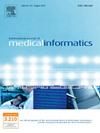A scoping review of digital solutions in diabetes outpatient care: Functionalities and outcomes
IF 3.7
2区 医学
Q2 COMPUTER SCIENCE, INFORMATION SYSTEMS
International Journal of Medical Informatics
Pub Date : 2025-05-09
DOI:10.1016/j.ijmedinf.2025.105967
引用次数: 0
Abstract
Background
Digital interventions are increasingly used in outpatient diabetes care to address growing healthcare demands and workforce limitations. This study investigates the functionalities of digital solutions and their impact on Quadruple Aim outcomes: enhancing population health, improving patient experience, supporting clinician well-being, and reducing healthcare costs.
Methods
We followed Joanna Briggs Institute guidelines, searching PubMed, Embase, Cochrane, Scopus, and Web of Science (January 2019–February 2024). Included studies reported digital diabetes interventions with outcomes directly relevant to the Quadruple Aim. Each intervention was mapped to a digital solution horizon: Horizon 1 involves foundational digital workflows; Horizon 2 leverages real-time data to create analytics; Horizon 3 encompasses transformative uses, such as predictive analytics.
Results
We identified 4,397 articles with 56 meeting the inclusion criteria. Interventions included telehealth (n = 15), mobile health (mHealth) (n = 20), combined telehealth and mHealth (n = 14), robotics (n = 1), electronic medical records (n = 1), and artificial intelligence (n = 5). Most interventions (n = 51) were categorised as Horizon 1, with 10 adopting Horizon 2, 5 using Horizon 3, and 10 spanning multiple horizons. Regarding Quadruple Aim outcomes, 44 studies addressed population health (41 positive), 31 targeted patient experience (29 positive), 4 focused on clinician well-being (3 positive), and 6 on cost reduction (4 positive).
Conclusion
Digital solutions have demonstrated measurable benefits, particularly in population health and patient experience. Most interventions remain at Horizon 1. Advancing these digital solutions to Horizon 2 and 3 is essential for system-wide transformation. Future research should include cost efficiency and clinician experience alongside evaluations of population health and patient experience.
糖尿病门诊护理数字化解决方案的范围综述:功能和结果
数字干预越来越多地用于糖尿病门诊护理,以解决日益增长的医疗保健需求和劳动力限制。本研究调查了数字解决方案的功能及其对“四重目标”结果的影响:增强人口健康,改善患者体验,支持临床医生福祉,降低医疗成本。方法我们按照Joanna Briggs研究所的指南,检索PubMed、Embase、Cochrane、Scopus和Web of Science(2019年1月- 2024年2月)。纳入的研究报告了数字糖尿病干预措施,其结果与“四重目标”直接相关。每个干预措施都映射到数字解决方案水平:水平1涉及基本的数字工作流程;《地平线2》利用实时数据进行分析;《地平线3》包含了一些变革性的用途,例如预测分析。结果共筛选到4397篇文献,其中56篇符合纳入标准。干预措施包括远程医疗(n = 15)、移动医疗(mHealth) (n = 20)、远程医疗和移动医疗相结合(n = 14)、机器人技术(n = 1)、电子病历(n = 1)和人工智能(n = 5)。大多数干预措施(n = 51)被归类为地平线1,其中10个采用地平线2,5个采用地平线3,10个跨越多个地平线。关于“四重目标”的结果,44项研究涉及人口健康(41项为阳性),31项研究针对患者体验(29项为阳性),4项研究关注临床医生福祉(3项为阳性),6项研究关注成本降低(4项为阳性)。结论数字解决方案已显示出可衡量的效益,特别是在人口健康和患者体验方面。大多数干预措施仍停留在地平线1。将这些数字解决方案推进到地平线2和地平线3对于整个系统的转型至关重要。未来的研究应包括成本效益和临床医生的经验,以及对人口健康和患者经验的评估。
本文章由计算机程序翻译,如有差异,请以英文原文为准。
求助全文
约1分钟内获得全文
求助全文
来源期刊

International Journal of Medical Informatics
医学-计算机:信息系统
CiteScore
8.90
自引率
4.10%
发文量
217
审稿时长
42 days
期刊介绍:
International Journal of Medical Informatics provides an international medium for dissemination of original results and interpretative reviews concerning the field of medical informatics. The Journal emphasizes the evaluation of systems in healthcare settings.
The scope of journal covers:
Information systems, including national or international registration systems, hospital information systems, departmental and/or physician''s office systems, document handling systems, electronic medical record systems, standardization, systems integration etc.;
Computer-aided medical decision support systems using heuristic, algorithmic and/or statistical methods as exemplified in decision theory, protocol development, artificial intelligence, etc.
Educational computer based programs pertaining to medical informatics or medicine in general;
Organizational, economic, social, clinical impact, ethical and cost-benefit aspects of IT applications in health care.
 求助内容:
求助内容: 应助结果提醒方式:
应助结果提醒方式:


